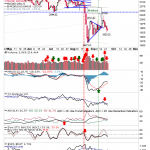Fox Business Network host Stuart Varney is as smart as they come, which is why I wasn’t surprised in the least that he cut right to the chase Monday morning, asking me within seconds of the market opening:
“What specific strategies can our viewers use to make a lot of money really fast in today’s markets?”
Two things, I replied.
You short the weakest companies – meaning you bet on them going down – and you buy the strongest companies because they’ve got what’s needed to survive turbulent market conditions.
But today, I want to tell you what I couldn’t say in the interest of time.
Right now I’m watching a key technical indicator we’ve seen only do what it’s doing now twice in the past 22 years. What’s more, this same indicator has heralded radically different market conditions than most investors expect both times it’s appeared.
And some whopping profits for investors who recognized it, too.
Today I want to tell you what “it” is and share a company that’s poised for profits as a result.
Here’s what you need to know.
It’s ALL About the Numbers
Many investors are at least vaguely familiar with the concept of technical analysis, especially when it comes to something called a “moving average.”
If you’re not or you’re just joining us, technical analysis is the use of statistics to analyze market activity. In contrast to fundamental analysis, there’s usually no attempt to determine an intrinsic value but, rather, what happens next.
And that’s where moving averages come in.
Moving averages are one of the simplest technical analysis tools out there. Nearly every charting package and financial site has them built in, which means you can add them to any chart on almost any investment any time you want.
What I like about moving averages is that they’re great at smoothing out variations in daily prices. Put another way, they eliminate noise – the stuff that confuses everybody else.













Leave A Comment